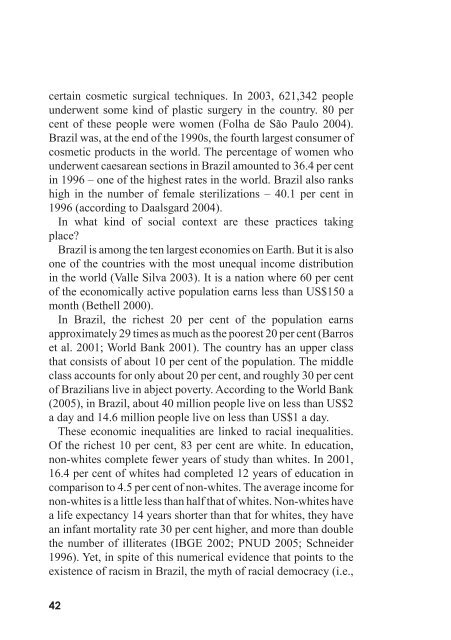Thinking with Bevereley Skeggs - Stockholms universitet
Thinking with Bevereley Skeggs - Stockholms universitet
Thinking with Bevereley Skeggs - Stockholms universitet
- No tags were found...
You also want an ePaper? Increase the reach of your titles
YUMPU automatically turns print PDFs into web optimized ePapers that Google loves.
certain cosmetic surgical techniques. In 2003, 621,342 peopleunderwent some kind of plastic surgery in the country. 80 percent of these people were women (Folha de São Paulo 2004).Brazil was, at the end of the 1990s, the fourth largest consumer ofcosmetic products in the world. The percentage of women whounderwent caesarean sections in Brazil amounted to 36.4 per centin 1996 – one of the highest rates in the world. Brazil also rankshigh in the number of female sterilizations – 40.1 per cent in1996 (according to Daalsgard 2004).In what kind of social context are these practices takingplace?Brazil is among the ten largest economies on Earth. But it is alsoone of the countries <strong>with</strong> the most unequal income distributionin the world (Valle Silva 2003). It is a nation where 60 per centof the economically active population earns less than US$150 amonth (Bethell 2000).In Brazil, the richest 20 per cent of the population earnsapproximately 29 times as much as the poorest 20 per cent (Barroset al. 2001; World Bank 2001). The country has an upper classthat consists of about 10 per cent of the population. The middleclass accounts for only about 20 per cent, and roughly 30 per centof Brazilians live in abject poverty. According to the World Bank(2005), in Brazil, about 40 million people live on less than US$2a day and 14.6 million people live on less than US$1 a day.These economic inequalities are linked to racial inequalities.Of the richest 10 per cent, 83 per cent are white. In education,non-whites complete fewer years of study than whites. In 2001,16.4 per cent of whites had completed 12 years of education incomparison to 4.5 per cent of non-whites. The average income fornon-whites is a little less than half that of whites. Non-whites havea life expectancy 14 years shorter than that for whites, they havean infant mortality rate 30 per cent higher, and more than doublethe number of illiterates (IBGE 2002; PNUD 2005; Schneider1996). Yet, in spite of this numerical evidence that points to theexistence of racism in Brazil, the myth of racial democracy (i.e.,42
















